Dark Planet: Battle for Natrolis Preview
It will build on a traditional real-time strategy formula and try to set itself apart with its unusual twists.
When a winning formula already exists, why try to reinvent it? That seems to be the thinking behind Ubi Soft's upcoming futuristic real-time strategy game called Dark Planet: Battle for Natrolis. This game will follow the proven RTS formula of harvest, build, and conquer that's been at the core of the genre for nearly a decade. What should set the game apart is its fine attention to detail, unusual mix of forces, and vibrant graphics.
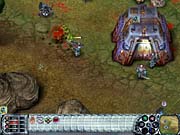
Dark Planet will play out on full-3D battlefields with 3D units. In your battle to control the verdant planet Natrolis, you'll get to fight with three different races. There are the high-tech human Colonists, the lizardlike Sorin, and insectile Dreil. Each race will get its own single-player campaign, though details of the overall story aren't clear at this stage. Suffice it to say, it will center on carnage. Multiplayer modes will let you fight up to seven other players, whether human or computer-controlled. You'll get skirmish, capture the flag, and domination modes, as well as five or so multiplayer campaigns.
Each race will have its own unique look and capacities. Colonist forces center on a control hub, a large structure whose computers and antennae provide command and control for your forces. Robotic "sapper" units will harvest rocks, crystals, and geothermal energy from the land. Sappers will also lay the groundwork for each new structure, after which a construction ship floats down from orbit and erects the new building.
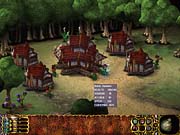
By upgrading your control hub, you'll get access to new buildings, like guard towers with long-range weapons or laboratories for upgrading your forces. A lab will let you research things like Kevlar plating to boost your troops' armor rating or special gauntlets for close combat. As you upgrade the control hub, you'll also gain access to new units, like medics or commanders who boost the abilities of nearby troops. You can also develop improved training for your units, which lets you create them more rapidly.
You'll fight with a variety of combat units. Marines, for instance, are your core warriors, armed with bayoneted rifles that offer a decent blend of short- and long-range power. Sentries specialize in close-quarters combat with their powered gauntlets, but they lack ranged weapons. Gunners can cause brutal long-range destruction with their fragmentation grenades, but they'll be in trouble if the fighting gets up close and personal.
Next there are the Sorin forces, which appear more like swords-and-sorcery lizardmen than the bug-eyed aliens you might expect. Their worker units, called slave hammers, gather wood and rock from the landscape. They also harvest a more unusual resource: faith, which is gathered from killing enemies and from worshiping at the temples that lie at the core of their civilization. Sorin buildings are humble affairs constructed of wood and stone, and their main military units fight with relatively primitive weapons like lances and bows. The Sorin's true power lies in their faith. The more faith you've stockpiled, the more your priest units get to cast powerful spells, letting them heal wounded comrades or raise zombie armies, for instance.
Commanding the Combatants
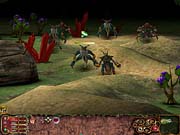
The third race you'll play as are the Dreil, whose pulsating organic buildings look like something from H.R. Giger's designs for the Alien films. The Dreil collect wood, crystals, and energy, the latter derived from enveloping fallen enemies in cocoons for further processing. Their insectile combat units include beasts like Spitters, which expel bursts of acid to eat the skin off enemies' bones.
Whether playing as the Dreil, Sorin, or Colonists, it looks like they'll be fairly easy to track and control. 3D strategy games have developed a reputation for clumsy or convoluted camera controls, but it seems like Dark Planet will get around any such problems smoothly. You'll zoom and rotate the camera with the mouse, and you'll pan it by moving the cursor to the edge of the screen. Currently, you need to use the keyboard to tilt the camera; hopefully, you'll get to do that with the mouse in the final version so that all the camera controls will be in one place. Either way, you can move the camera from a somewhat distant overhead view down to a ground level close-up for a more intimate look.
Much of Dark Planet's interface will wisely follow established genre conventions, which should mean less time learning and fumbling and more time playing. You simply left-click a unit to select it, double-click one to select all the other units of that type, and bandbox multiple units to create a group. You can then assign numbers to each group to let you easily jump to it. To give a unit an order, simply right-click a spot on the ground to move there or click another unit or object to attack it, harvest it, and so forth. The cursor icon changes appearance contextually to let you know what your mouse click will do. So, if you place the cursor over a pile of stone while you have a harvester unit selected, the cursor will change into a tiny pile of stone.
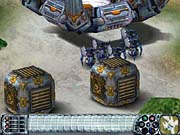
Hovering the cursor over any unit or building will reveal all the vital information you need to know about it. Each unit is rated for health, armor, attack power, and speed. Resource-collecting units, which also handle repairs of damaged structures, are additionally rated for carrying capacity.
You'll be able to move grouped units into triangular, square, or circular formations, as well as create your own formations. In a somewhat unusual twist, you can also expand and contract formations with the click of a button for better overall line of sight or greater safety. You can also set unit combat stances, choosing from flee on contact, stand ground, alerted, and aggressive stances. You'll get to issue patrol orders by creating a series of waypoints. Where applicable, units will display their group number and combat stance with little color-coded icons above their heads to help you track your units and their current settings. That sort of attention to little details seems indicative of Dark Planet as a whole.
Sweating the Small Stuff
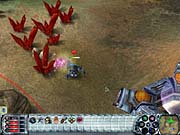
Edgies is clearly paying a lot of attention to creating a smooth, intuitive, and attractive interface. Dark Planet concentrates all the important data and detailed command options at the bottom of the screen. There, you'll find your resource totals, as well as the actual and potential population of your forces. A group of icons for general options lets you change the game settings, toggle a minimap on the main screen, display your current mission objective, and move the camera directly to your central base. You'll also find a convenient compass needle that shows the current map orientation and also lets you reorient the map so that the top of the screen points north.
Along with these general options, you'll see a row of dynamic commands that apply to your currently selected units. As with all the other commands, these are presented with colorful icons whose meaning should be clear at a glance: select a Colonist sapper unit, for example, and you'll see a tool-shaped icon for issuing a repair command. Clicking an outstretched hand icon causes the unit to stop its current action. Selecting some command icons will temporarily display a second row of further options, like the possible unit formations. While these icons look like they'll be easily distinguished at a glance, you'll also find convenient pop-up tool tips that briefly name each one's function. If you'd like to simply avoid the command menu, you can resort to hotkeys for giving more rapid orders.
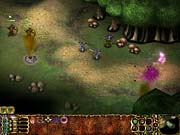
The interface panels change for each species to reflect their unique styles. When playing as the Sorin, for instance, the main lower panel appears to be lined with lizard skin. That sort of attention to visual detail looks like it will carry over into the whole game. The landscapes are richly and vividly colored, and they're alive with native roaming animals and trees whose foliage sways gently in the wind. Sparkling, undulating waves lap against the shore, and schools of tiny, wriggling fish dart about in the water. Rainstorms wash over the landscape, leaving little puddles, and the battlefield is enveloped in darkness as the sun sets.
The units and combat effects look like they'll be equally colorful. When you upgrade a Colonist hub, for instance, massive spires reach upward and outward, sprouting whirling antennae. Colonist marines jerk back from the recoil of their huge rifles, and Sorin leave bloody pink smears across the landscape when killed. Buildings catch fire when attacked, eventually exploding in magnificent bursts of flames and smoke.
While there's no music in place yet, Dark Planet's sound effects seem colorful. Combat is a riot of chattering machine gun fire, thundering explosions, and the moans of the dying. Ambient sounds like gentle breezes should help bring Natrolis to life.
Dark Planet: Battle for Natrolis is scheduled to be released in late February, and it's looking quite polished at this point. Dark Planet looks like it should offer fairly traditional RTS gameplay--but with the attention to detail and a memorable setting that could set it apart from its peers.
Got a news tip or want to contact us directly? Email news@gamespot.com
Join the conversation